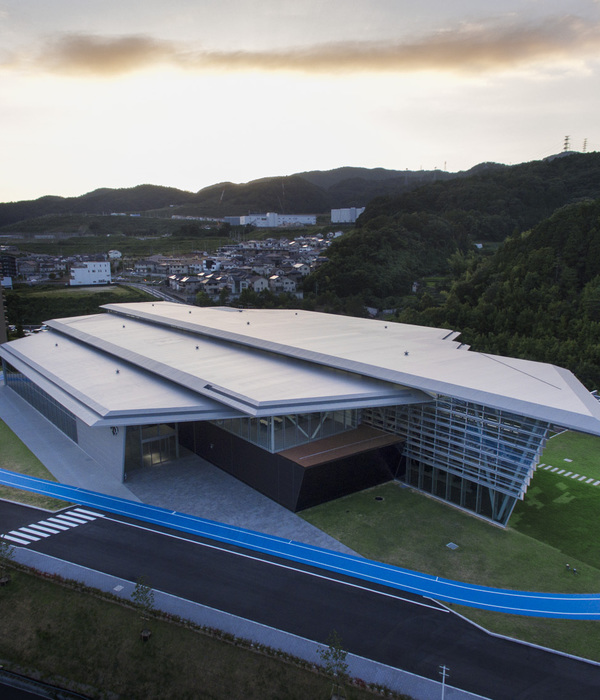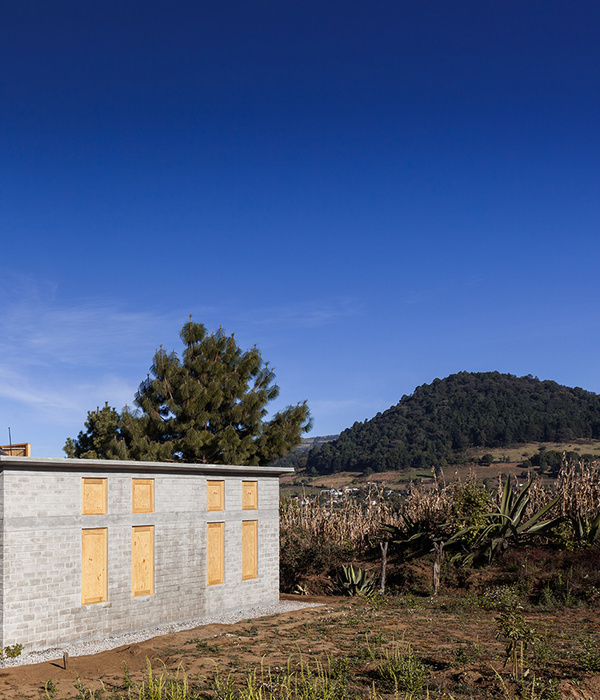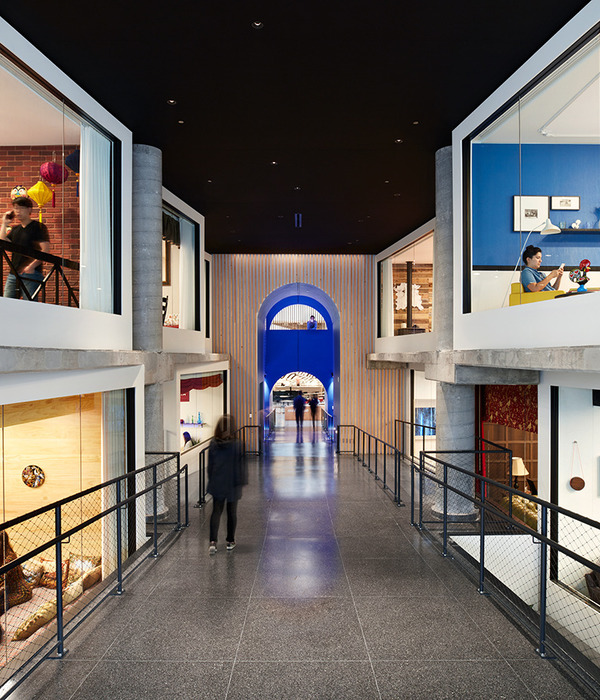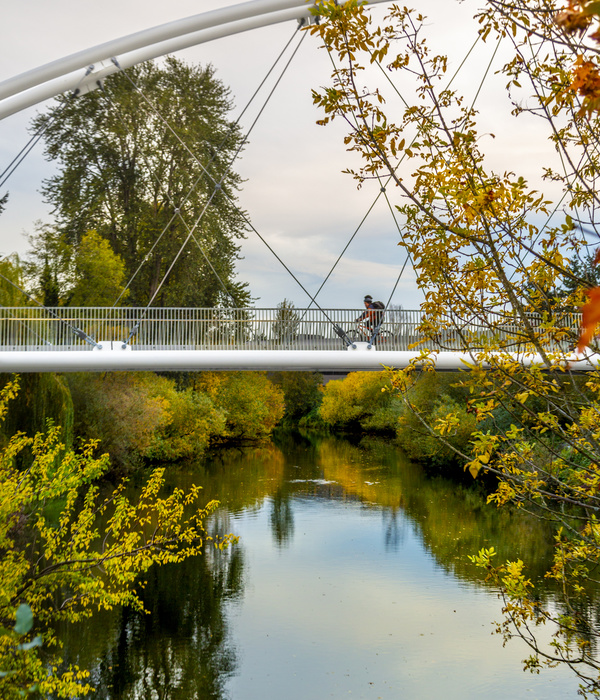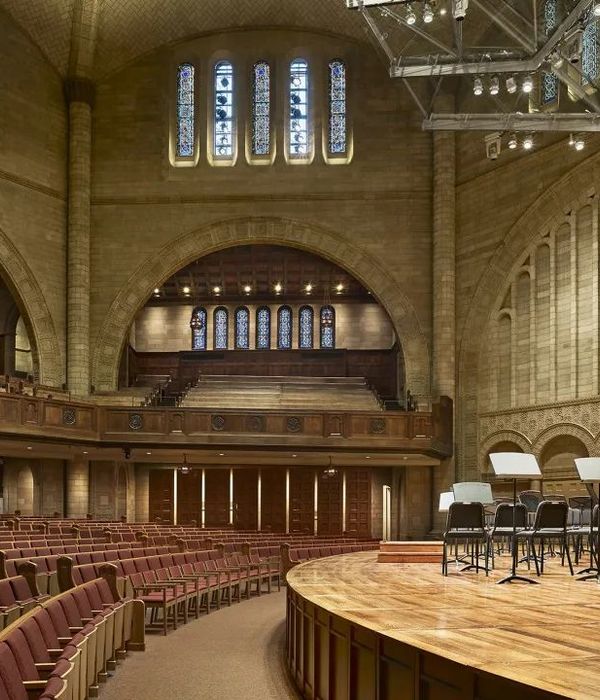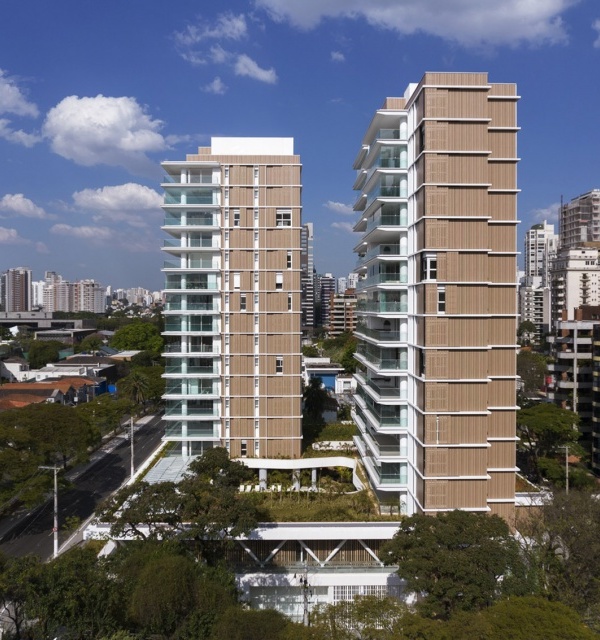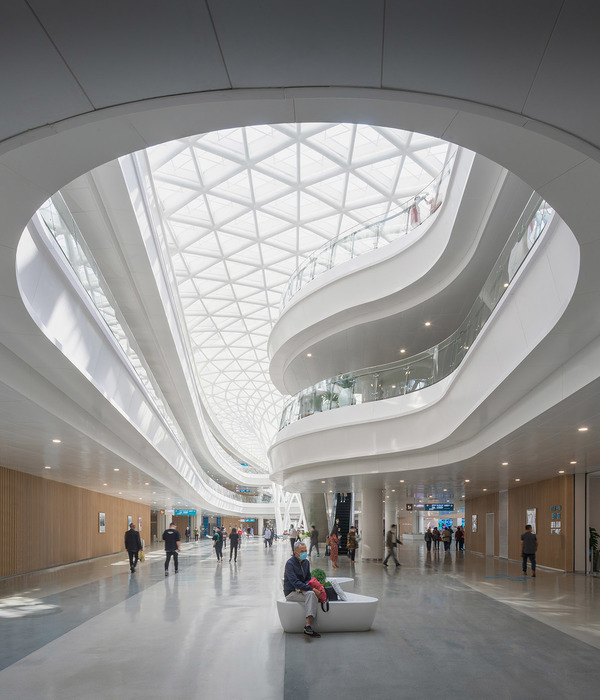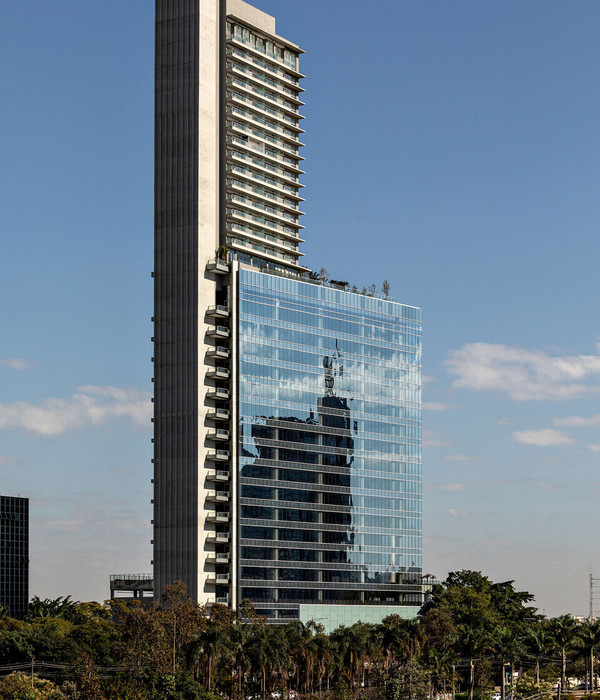在海得拉巴(Hyderabad)干燥而又炎热的气候下,绝大多数的办公人士不得不待在空调房里,鲜少有机会呼吸户外的新鲜空气。海得拉巴从曾经的悠闲小镇逐渐转变成了一个富有竞争力的国际都市,吸引了许多大型科技公司——它们每年大约要建造数百万平方英尺的办公空间。这些新的建筑在设计上往往很少考虑当地的气候和文化条件:密封的玻璃盒子全靠空调来调节温度,全然不顾当地冬夏气候的剧烈波动。这种依赖机械控制的建筑模式延续了二战后涌现于北美的办公建筑类型,并迅速地蔓延至全世界希望迅速发展经济的地区。
▼项目概览,general view © Vivek Eadara Photography
In Hyderabad’s dry, hot climate, the vast majority of office-goers are resigned to spend their entire day within the confines of an air conditioned space with very little access to fresh air from the outdoors. Hyderabad–a once laid back town– is now a competitive cosmopolitan city, attracting many big-tech companies, who build millions of square feet of office space per year. Very few of these new structures consider local climate and culture conditions in their design. Most of these new office buildings are sealed-off glass boxes that rely heavily on air conditioning to maintain a specific indoor temperature consistently throughout the year, whatever weather fluctuations Hyderabad’s seasons might bring: hot summers, pleasant monsoons, and tolerable winters. This building paradigm, mechanically controlled and indifferent to context, perpetuates a corporate office typology that first emerged post-WWII in North America, and which soon spread to anywhere hoping to participate in the new high-speed world economy.
▼入口围墙,the enclosure © Vivek Eadara Photography
该项目的设计任务是要将一座既有的混凝土框架结构改造为MGB汽车经销商的办公总部。对此,设计团队希望采用曾经被原始设计所忽略的方式,专注于使用能够优化建筑气候适应力的设计元素。在建筑的第1层、第3层和未来将要建造的第5层,有节奏地置入了一个屏墙系统——由固定在金属框架上的3mm金属板面构成——将整个建筑包围起来。
▼施工前后对比,before and after © Spacefiction Studio
Tasked with repurposing an existing concrete framed structure on-site into an Auto dealership office headquarter, we focused on design elements that could optimize the building’s climate responsiveness [ in ways overlooked by the original design.] To this end, we built on our practice’s ongoing research into perforated screens as a way to blur the boundaries between inside and outside. Here, a system of screens rhythmically placed on the 1st, 3rd and a future 5th envelops the building. A 3mm metal sheet with 8mm perforations, held together by a well integrated metal frame, make up the screening system.
▼金属穿孔板构成的屏墙系统 © Vivek Eadara Photography a screening system made of perforated metal sheets
建筑的西侧通常要接受大部分的阳光直射,因此将楼梯和洗手间设置在该侧,使其呈现为朴素的立面。这一举动也为作为主要功能的办公空间留出了充裕的无柱空间。建筑南侧朝向街道,在一天中也会受到阳光的剧烈照射。
The western edge of the building that typically receives a majority of direct sunlight is blocked by placing the staircase and toilets along that edge, making it the austere facade. This leaves the remainder of the column-free floor plate for the main program – workspaces. The southern edge, which also receives a brunt of the harsh daylight, happens to be the street-facing facade of the building.
▼接待和等候区,reception and waiting area © Monika Sathe Photography
▼置物架隔墙,shelving partitions © Monika Sathe Photography
▼询问桌,interaction desks © Monika Sathe Photography
▼讨论室,discussion room © Monika Sathe Photography
▼细节,detailed view © Monika Sathe Photography
设计中的一个重要考量是屏墙系统在立面上的具体组合与呈现方式。设计团队为屏墙赋予了活泼而轻盈的几何图案,使其成为街道上的一处独特景象。丰富多彩的外观同时也为街道对面的幼儿园里的小朋友们带来了一些视觉上的乐趣。
An important consideration for us was the details of the assemblage and appearance of the screening system on the facade. The geometric pattern at which we arrived for the screen has a playfulness and lightness that gives the building a distinct identity on the street. An additional consequence of the colorful facade is the visual interest it generates for our tiny neighbors in the kindergarten across the street.
▼屏墙起到过滤阳光的作用 the screening system filters the sunlight © Monika Sathe Photography
▼阳台,balcony © Monika Sathe Photography
▼阳台和办公空间,balcony and office © Monika Sathe Photography
在未得到充分利用的昏暗的楼梯间内,增加了许多嵌入式的座位,可以作为员工的交谈或休息空间。主办公区以经典的方式进行组织和布局,分布在大楼的4个楼层,其中第4层是主管们的专用办公区域。不过,对于所有人而言,从建筑的任何位置都可以直接走向户外空间,体现了公司民主且慷慨的制度理念。
Out of the underutilized, dark spaces of the stairway are carved many niche seating areas, often used by the staff for gathering or for solitude. Meanwhile, the main workspaces are organized in a typical, hierarchical manner, spread across the 4 floors, with the 4th floor dedicated for the executives. However, every individual, anywhere in the building, has direct access to the outdoor space: a generous, democratic provision.
▼走廊,corridor © Monika Sathe Photography
▼楼梯间增加了嵌入式的座位,dark spaces of the stairway are carved many niche seating areas © Monika Sathe Photography
▼开放办公区,open workspace © Monika Sathe Photography
▼独立办公间,office cabins © Monika Sathe Photography
▼会议室,conference room © Monika Sathe Photography
▼休息区,waiting lounge © Monika Sathe Photography
阳台上摆放着易于养护的绿色植物,与后方的黄色和橙色屏墙形成了并列和对照的关系。所有的门窗都可以手动控制,从而可以直接从办公室走向户外空间,同时实现交叉通风,减少使用者对空调的依赖。
The balconies are populated with easy-maintenance plants and create a juxtaposition of green plants and yellow-orange screens behind it. All the windows and doors are operable making the balcony accessible from all the workspaces, enabling the opportunity to open the windows for cross ventilation. This also gives the users the option to reduce dependency on air conditioning.
▼从外部望向阳台,balcony exterior view © Vivek Eadara Photography
▼立面夜景,facade night view © Vivek Eadara Photography
不同于应对海德拉巴高温天气的常见做法,MGB总部的设计提供的是一种被动的降温方式,在为使用者带来舒适环境的同时,也向典型的玻璃盒子式的办公建筑提出了挑战。
The MGB headquarters transcends the most common approaches to deal with Hyderabad’s heat, and offers a method for passive cooling that benefits its occupants and as importantly, challenges the typical glass box typology of office building.
▼建筑局部,exterior partial view © Vivek Eadara Photography
▼夜间整体外观,general view by night © Vivek Eadara Photography
▼细节示意,detail © Spacefiction Studio
▼绿色表皮示意,green skin © Spacefiction Studio
▼一层和二层平面图,first floor plan & second floor plan © Spacefiction Studio
▼三层和四层平面图,third floor plan & fourth floor plan © Spacefiction Studio
▼南立面图和东立面图,south elevation & east elevation © Spacefiction Studio
{{item.text_origin}}

